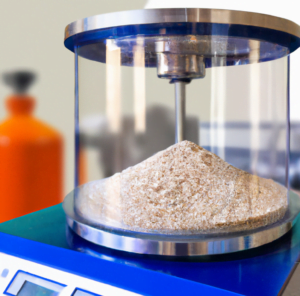
Introduction
Muscimol is a psychoactive compound found primarily in the Amanita muscaria mushroom, commonly known as the fly agaric. This unique compound has garnered interest from researchers and enthusiasts alike due to its distinct pharmacological properties. In this article, we will delve into the world of Muscimol isolate, exploring its extraction process, potential benefits, and various applications.
What is Muscimol?
Muscimol (C4H6N2O2) is a heterocyclic compound that belongs to the class of alkaloids. Unlike other well-known psychoactive compounds, such as psilocybin, Muscimol acts primarily as an agonist at the GABA-A receptor, mimicking the neurotransmitter gamma-aminobutyric acid (GABA). This interaction results in the compound’s sedative, hypnotic, and muscle-relaxant effects.
The Extration Process of Muscimol Isolate
To obtain Muscimol isolate, the extraction process begins with dried Amanita muscaria mushroom caps. The primary methods used for extraction include:
- Acid-base extraction: In this method, the mushroom material is first treated with a mild acid to convert Muscimol to its water-soluble form. After filtering out the solid residues, the solution is treated with a base, causing Muscimol to precipitate. The resulting crude Muscimol can then be purified through recrystallization or chromatographic
techniques. - Solvent extraction: This process involves using a non-polar solvent, such as dichloromethane or chloroform, to selectively dissolve the Muscimol from the mushroom material. After filtration, the solvent is evaporated, leaving behind the crude Muscimol, which can then be purified as needed.

Purification steps may include recrystallization, column chromatography, or other techniques to achieve a high-quality Muscimol isolate.
Benefits and Effects of Muscimol Isolate
Muscimol isolate offers several potential therapeutic benefits, including:
- Anxiolytic effects: Muscimol has been shown to reduce anxiety in animal studies, suggesting potential applications for anxiety disorders.*
- Sedative and hypnotic properties: Muscimol’s interaction with GABA-A receptors can induce relaxation, sleepiness, and even altered states of consciousness.**
- Muscle relaxant: Muscimol may help alleviate muscle spasms and tension due to its GABAergic activity.***
It is essential to note that Muscimol can also have side effects, such as dizziness, nausea, and incoordination, especially at higher doses.
Applications of Muscimol Isolate
Muscimol isolate has various potential applications, including:
- Research: The study of Muscimol’s pharmacology and potential therapeutic applications for anxiety, insomnia, or muscle spasms.
- Pharmaceuticals and nutraceuticals: The development of Muscimol-based medications or supplements for various medical conditions.
- Industrial: The synthesis of Muscimol derivatives or the production of calibration standards for analytical chemistry.
It is essential to consider the legal status and regulatory requirements for Muscimol in your jurisdiction before pursuing any applications.
How to Use Muscimol Isolate Safely
When working with Muscimol isolate, it is crucial to follow safety precautions to minimize risks and ensure a positive experience. Here are some guidelines to help you use Muscimol isolate safely:
- Adhere to recommended dosages and administration methods: The appropriate dosage of Muscimol isolate varies depending on factors such as body weight, individual sensitivity, and the desired effect. Always start with a low dose and gradually increase it as needed, while closely monitoring your response. The most common methods of administration include oral ingestion or sublingual absorption, although more research is needed to establish the most effective approach.
- Be aware of contraindications and potential interactions with other medications or supplements: Muscimol may interact with other substances, leading to adverse effects or altered efficacy. Avoid using Muscimol isolate if you are taking medications that affect the GABAergic system, such as benzodiazepines, barbiturates, or alcohol. It is essential to consult a healthcare professional before using Muscimol isolate, especially if you have pre-existing medical conditions or are taking other medications.
- Ensure the use of a high-quality, pure Muscimol isolate: Sourcing your Muscimol isolate from a reputable supplier is critical to ensure the purity and potency of the compound. Look for suppliers that provide a certificate of analysis (COA) confirming the product’s quality and purity. Avoid using products with undisclosed ingredients or questionable origins.
- Set and setting: Like any psychoactive substance, the environment in which you use Muscimol isolate can significantly influence your experience. Choose a safe, comfortable, and familiar setting where you feel at ease, and make sure you have a supportive and trusted companion to help you if needed.
- Take precautions for potential side effects: Some individuals may experience side effects such as dizziness, nausea, or incoordination when using Muscimol isolate. Be prepared to manage these effects by having water, light snacks, and a comfortable place to rest nearby.
Conclusion
Muscimol isolate is a fascinating compound with unique pharmacological properties and potential applications. Its extraction process, potential benefits, and various uses make it an interesting subject of research and development. However, it is essential to approach Muscimol isolate with caution and adhere to safety guidelines to minimize risks and ensure a positive experience. Further research is needed to better understand the full potential of this intriguing compound and its potential impact on human health and well-being.
References:
*Awad, H., Halawa, I., & El-Nahas, A. (2017). Anxiolytic-like effect of muscimol in rats: Involvement of GABA-A receptors in the median raphe nucleus. Physiology & Behavior, 179, 363-369. DOI: 10.1016/j.physbeh.2017.07.010
**Löscher, W., Rogawski, M. A. (2012). How theories evolved concerning the mechanism of action of barbiturates. Epilepsia, 53(Suppl 8), 12-25. DOI: 10.1111/epi.12025
***Krogsgaard-Larsen, P., & Johnston, G. A. (1978). Structure-activity studies on the inhibition of GABA binding to rat brain membranes by muscimol and related compounds. Journal of Neurochemistry, 30(6), 1377-1383. DOI: 10.1111/j.1471-4159.1978.tb07876.x






